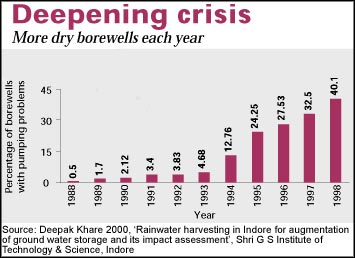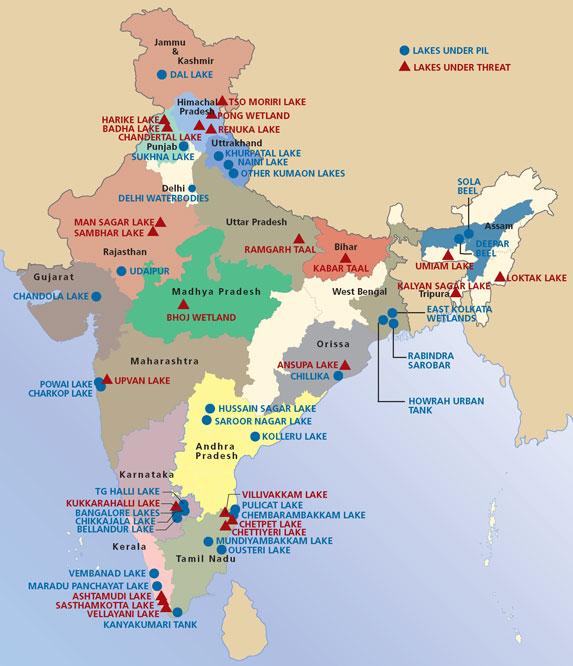! Conserve water !
Rain water harvesting....
Rain water harvesting is one of the best way to save water as rainwater is free from pollutants as well as salts, minerals, and other natural and man-made contaminants. In areas where there is excess rainfall, the surplus rainwater can be used recharge ground water through artificial recharge techniques . As the population is growing day by day the need of water is also increasing at the same rate.
Rainwater harvesting is the accumulation and deposition of rainwater for reuse on-site, rather than allowing it to run off. Its uses include water for garden, water for livestock, water for irrigation, water for domestic use with proper treatment, and indoor heating for houses etc. In many places the water collected is just redirected to a deep pit with percolation. The harvested water can be used as drinking water as well as for storage and other purpose like irrigation.

WHY RAIN WATER HARVESTING :
Rain water harvesting is essential because :-
Surface water is inadequate to meet our demand and we have to depend on ground water.
Due to rapid urbanization, infiltration of rain water into the sub-soil has decreased drastically and recharging of ground water has diminished.
As you read this guide, seriously consider conserving water by harvesting and managing this natural resource by artificially recharging the system. The examples covering several dozen installations successfully operating in India constructed and maintained by CGWB, provide an excellent snapshot of current systems.
RAIN WATER HARVESTING TECHNIQUES :
There are two main techniques of rain water harvesting:
Storage of rainwater on surface for future use.
Recharge to ground water.
The storage of rain water on surface is a traditional techniques and structures used were underground tanks, ponds, check dams, weirs etc. Recharge to ground water is a new concept of rain water harvesting and the structures generally used are :-
Pits :- Recharge pits are constructed for recharging the shallow aquifer. These are constructed 1 to 2 m, wide and to 3 m. deep which are back filled with boulders, gravels, coarse sand.

Advantages of Rain water harvesting
1. Easy to Maintain:The overall cost of their installation and operation is much lesser than that of water purifying or pumping systems. Maintenance requires little time and energy. The result is the collection of water that can be used in substantial ways even without purification.
2. Reducing Water Bills: Water collected in the rainwater harvesting system can be put to use for several non-drinking functions as well. For many families and small businesses, this leads to a large reduction in their utilities bill. On an industrial scale, harvesting rainwater can provide the needed amounts of water for many operations to take place smoothly without having to deplete the nearby water sources.It also lessens the burden of soil erosion in a number of areas, allowing the land to thrive once again.
3. Suitable for Irrigation: As such, there is little requirement for building new infrastructure for the rainwater harvesting system. Most rooftops act as a workable catchment area, which can be linked to the harvesting system. This also lessens the impact on the environment by reducing use of fuel based machines.
4. Reduces Demand on Ground Water: With increase in population, the demand for water is also continuously increasing. The end result is that many residential colonies and industries are extracting ground water to fulfill their daily demands. This has led to depletion of ground water which has gone to significant low level in some areas where there is huge water scarcity.
5. Reduces Floods and Soil Erosion: During rainy season, rainwater is collected in large storage tanks which also helps in reducing floods in some low lying areas. Apart from this, it also helps in reducing soil erosion and contamination of surface water with pesticides and fertilizers from rainwater run-off which results in cleaner lakes and ponds.
6. Can be Used for Several Non-drinking Purposes: Rainwater when collected can be used for several non-drinking functions including flushing toilets, washing clothes, watering the garden, washing cars etc. It is unnecessary to use pure drinking water if all we need to use it for some other purpose rather than drinking.

Disadvantages of Rain water harvesting
1. Unpredictable Rainfall: Rainfall is hard to predict and sometimes little or no rainfall can limit the supply of rainwater. It is not advisable to depend on rainwater alone for all your water needs in areas where there is limited rainfall. Rainwater harvesting is suitable in those areas that receive plenty of rainfall.
2. Initial High Cost: Depending on the system’s size and technology level, a rainwater harvesting system may cost anywhere between $200 to $2000 and benefit from it cannot be derived until it is ready for use. Like solar panels, the cost can be recovered in 10-15 years which again depends on the amount of rainfall and sophistication of the system.
3. Regular Maintenance: Rainwater harvesting systems require regular maintenance as they may get prone to rodents, mosquitoes, algae growth, insects and lizards. They can become as breeding grounds for many animals if they are not properly maintained.
4. Certain Roof Types may Seep Chemicals or Animal Droppings: Certain types of roofs may seep chemicals, insects, dirt or animals droppings that can harm plants if it is used for watering the plants.
5. Storage Limits: The collection and storage facilities may also impose some kind of restrictions as to how much rainwater you can use. During the heavy downpour, the collection systems may not be able to hold all rainwater which ends in going to to drains and rivers.

Methods of Rain water harvesting
Water spreading
Recharge through pits, trenches, wells, shafts
Rooftop collection of rainwater
Road top collection of rainwater
Induced recharge from surface water bodies.
Recharge through pits, trenches, wells, shafts
Rooftop collection of rainwater
Road top collection of rainwater
Induced recharge from surface water bodies.

Reviews in INDIA
India
- In the state of Tamil Nadu, rainwater harvesting was made compulsory for every building to avoid ground water depletion. It proved excellent results within five years, and every state took it as role model. Since its implementation,Chennai saw a 50 percent rise in water level in five years and the water quality significantly improved.
- In Rajasthan, rainwater harvesting has traditionally been practiced by the people of the Thar Desert. There are many ancient water harvesting systems in Rajasthan , which have now been revived . Water harvesting systems are widely used in other areas of Rajasthan as well, for example the chauka system from the Jaipur district.
- At present, in Pune (in Maharashtra), rainwater harvesting is compulsory for any new society to be registered.
- An attempt has been made at Dept. of Chemical Engineering, IISc, Bangalore to harvest rainwater using upper surface of a solar still, which was used for water distillation.

As we all know that we need to wake up and conserve water for our future then Rain water harvesting is the one . If you want rain water harvesting to be done to save our generations and future then the solution is here:
Either it is a group of apartments or independent houses we are here to give you the suitable pit.
If you live in a single dwelling house or a multi-tenant apartment complex, you already have 80% of the RWH system. We just need re-orient the plumbing design.The present design of the house will take all the rainwater from the roof and all the ground level areas surrounding the house and flow the water towards the street .From the roof tops, bring the rainwater down using closed PVC pipes and direct it to a sump which Include a simple 3-part filtration unit consisting of sand, brick jelly and broken mud bricks If you do not have sump we can use a well.

For details contact :
Gautam Kumar . Y
9492435355
No comments:
Post a Comment